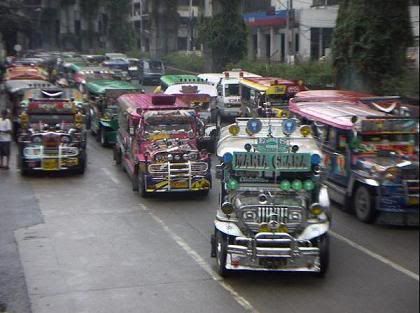Unsafe at any speed....
The title of this blog post is a nod towards Ralph Nader's polemic 1965 book of the same title, responsible for bringing the issue of automotive safety into the eyes of the American public. Maybe, just maybe, this post could have a similar effect with respect to the Philippine public regarding the ubiquitous passenger jeepney.

In May of 2005, I wrote a blog post about why passenger jeepneys should be phased out. After six years, I think the time is right to revisit this issue.
Let's get straight to the point. My opinion on this hasn't changed. I personally feel that contemporary jeepneys should be phased out.
Jeepneys are throwbacks to a long bygone era, and are potential deathtraps for the people who drive them, the people who ride them, and the people who walk around them, the people who drive around them.
Think about it. While passenger cars have grown a long laundry list of safety features over the past several decades in an effort to reduce fatalities in accidents, jeepneys have essentially remained unchanged in design and concept after they first came into being after the close of the Second World War. In other words, they are hardly any safer now than they were before. And with engine power increasing leading to higher and higher road speeds, jeepneys are probably more dangerous now than they ever were before.
Skeptical? Just Google jeepney accidents Philippines.
But why blame the passenger jeepney? According to the Department of Transportation and Communications (DOTC), the leading cause of road accidents is human error. While I'm not disputing this fact, the thing is, while human error really does cause accidents, properly implemented vehicle safety features can do a lot to reduce fatalities and injuries by: 1) Improving the vehicle's ability to avoid accidents (active safety); or 2) Significantly reducing or redirecting the crash forces involved if an accident does occur (passive safety);
The point of the matter is, passenger jeepneys as we know them substantially lack both.
Simple things we take for granted in passenger cars that are typically absent from passenger jeepneys which could help them avoid accidents in the first place:
Working dashboard gauges and warning lights, particularly speedometers;
Working and visible park lights, turn signal lights, brake lights, tail lights and reversing lights;
Efficient or even working windshield wipers;
All you have to do is ride one or look around when you're on the road. I wonder how these vehicles can pass inspection when their registrations are renewed.
Front disc brakes.
A significant number of jeepneys still get by using front drum brakes when virtually everything else on the road has moved on to front disc brakes since the 60s. Couple drum brakes' tendency to fade under frequent braking typical in city driving and for picking up passengers, or to lock up under hard braking, and with long daily duty cycles, and inadequate maintenance, you have a surefire recipe for road accidents waiting to happen.
Then there's absent passive safety features which should kick in when an accident is inevitable:
No properly engineered crumple zones;
No side impact protection;
No padded dashboards;
Inadequate, non-functional or absent seatbelts for the front drivers and passengers;
Exposed bare metal which could easily rip flesh of passengers in an accident;
Little or no padding for rear passengers, unless you count fellow passengers as padding;
Ornamentation on the front and rear which could easily impale pedestrians or exacerbate damage to others cars even in low speed collisions;

The front of a contemporary jeepney can rip an unwitting pedestrian to shreds. The forest of poles, antennae and metal ornaments can impale people, the front bumpers and bars can break legs or mangle other cars' bumpers. Artistic? Perhaps. Safe? No.
I know that jeepneys are a testament to Filipino ingenuity. I know that they are unique to our culture. I know that jeepneys are as Filipino as say, adobo or the carabao, but no matter how you slice it, jeepneys are just unsafe. Better that they be in museums than on public roads.
A lot of them are fabricated using surplus right-hand drive components which are of questionable safety and reliability in a left-hand drive road network. They're also wasteful, noisy and dirty. They're heavy, aerodynamically inefficient behemoths, with unmuffled exhausts filling the air with tons of unburned hydrocarbons thanks to the proliferation of surplus diesel engines which aren't rebuilt to spec.
If private vehicles have to meet safety, noise and emission requirements and regulations, why can't we be more strict when it comes to public vehicles, especially jeepneys? There are already regulations when it comes to basic roadworthiness and acceptable levels of noise and pollution yet we do not seem to have the political will to implement these consistently.
I just find it shocking that we can turn a blind eye to these things even though our loved ones ride these things everyday to work and to school.
As I've said in my earlier blog post, it is not being suggested that jeepneys be phased out abruptly. It is recognized that a lot of Filipinos rely on jeepneys as their means of livelihood. The phasing out of jeepneys as we know them can be done in a span of years or even decades, while alternative modes of transportation are phased in, or the jeepney reengineered to be safer.
I'm not anti-jeepney per se. Just given a choice between tradition and safety, I'll sure as hell choose safety. Especially when friends and family, commuters, pedestrians and drivers alike are at risk every day.
Comments